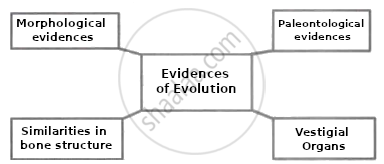Advertisements
Advertisements
प्रश्न
Complete the following chart:

उत्तर

APPEARS IN
संबंधित प्रश्न
Mammals : _________ : : Amphibia : Fishes
Four students A, B, C and D reported the following set of organs to be homologous. Who is correct ?
(A) Wings of a bat and a butterfly
(B) Wings of a pigeon and a bat
(C) Wings of a pigeon and a butterfly
(D) Forelimbs of cow, a duck and a lizard
Explain the terms analogous and homologous organs with examples.
Enlist any four sequential evolutionary names of human ancestors.
Name the scientists who Discovered the fossil of Australopithecus
Explain the evolution of giraffe's neck according to Lamarck's theory of evolution.
Differentiate between analogous and homologous structures.
Select and write analogous structures from the list given below :
1) Wings of butterfly and birds
2) Vertebrate hearts
3) Tendrils of Bougainvillea and Cucurbita
4) Tubers of sweet potato and potato
The organs which perform different functions but have the same basic structure are known as :
(a) homologous organs
(b) analogous organs
(c) homolytic organs
(d) analytic organs
The organs which perform similar functions but have different basic structure are called :
(a) asymmetric organs
(b) analogous organs
(c) homologous organs
(d) homophonic organs
Some dinosaurs had feathers although they could not fly birds have feathers that help them to fly. In the context of evolution, this means that ______
Identify the following pairs as homologous and analogous organs:
(i) Sweet potato and potato
(ii) Eye of octopus and eye of mammals
(iii) Thorns of Bougainvillaea and tendrils of Cucurbits
(iv) Fore limbs of bat and whale
Select a set of homologous organs from the following:
(A) Wings of a bat and wings of a butterfly
(B) Wings of a pigeon and wings of a bat
(C) Wings of a butterfly and wings of a pigeon
(D) Forelimbs of a duck, forelimbs of a cow and forelimbs of a lizard
In a class, students were asked to observe the models/slides/pictures of the skeletons of forelimbs and wings of different organisms. After the observations the students made the following groups of homologous structures. Select the correct group :
(A) Wings of a bird and a butterfly
(B) Wings of a pigeon and a bat
(C) Wings of a butterfly and a bat
(D) Forelimbs of a cow, a duck and a lizard
Write the names of those animals in whom the human body organs are functioning.
The most common types of fossils are ------------------------.
Choose the correct option of the following question:
Wings of Insect and Birds are examples of :
Differentiate between connecting links and the missing links.
Very short answer question:
What is vestigeal organ?
Short answer question.
Give the significance of fossils.
Find an odd one out.
The decaying process of C-14 occurs continuously in dead organisms only.
Give scientific reason.
Peripatus is said to be the connecting link between Annelida and Arthropoda.
Give scientific reason.
Vertebrates have slowly originated from invertebrates.
Complete the flowchart.

Enlist the evidences of evolution.
Evolutionary convergence is the development of:
Flippers of Penguins and Dolphins are examples of:
Fossils are generally found in ______.
Did aquatic life forms get fossilised? If, yes where do we come across such fossils?
How do we compute the age of a living tree?
While creation and presence of variation is directionless, natural selection is directional as it is in the context of adaptation. Comment.
What is the function of the appendix of our digestive system?
Find odd one out:
As shown in figure below some organisms that share a common ancestor have features that have different functions, but similar structures.

These are known as ______. Give example.
Write avian characters of Archaeopteryx.
